Cities of the World
an infinity (Video Art from São Paulo)
Curated by Michel Pavlou
Approaching "Guarulhos" International airport, this morning in late august 2009, I asked my Brazilian neighbor on the flight how long does it take from the airport to the city; "a few years ago it took about an hour; today the city's suburbs have already surrounded the airport", he said. "But then, how many people live here?" I replied. "20, 25 maybe 30 millions, we cannot say exactly".
I then realized that in cities like São Paulo there is what is measurable and what is not and that it is this later aspect that I would like to experience.
During the festival (I was invited as video artist of the 18th edition) I stayed in the vicinity of the festival's sites, then, the remaining few days, I decided to take off, to go further inside the "monster" to reach its tender facets.
At first glance, all these megacities look similar to each other in their inhuman and uncaring aspects. They hide their singularity behind anonymous, nondescript spaces, "espaces quelconques" as Deleuze calls them; large boulevards, huge parking lots, terminals of any kind, wastelands, shopping centers, administrative buildings... You have to get lost, to get carried away by the flow of the city, let it show you what it wants to show you, you will then get the chance to find these paths that lead to its soul, to go beyond the appearances of globalization. Unfortunately, my very limited time did not allow me to take full advantage.
Meanwhile, I was immersed in the task of this selection with the aim and hope to retrieve the same kind of premonitions and vibrations I've experienced in the city, at the edge of some passages that I did not dare to take, ahead of these doors that I did not dare to open, among people that I did not dare to talk to; because I felt intrusive, unprepared, fearful, nervous, intimidated. Was it because of the unknown or because of something very familiar, hidden in the shadow lands of my childhood? So far away and yet so close to the starting point? The impossible escape? The perpetual homecoming?
The resulting program is very subjective and cannot claim to be representative of the video art scene in São Paulo.
I've selected artists who are "on the move", in a permanent state of struggle and friction with their environment, their identities, their history and their production tools and media. Artists who have adopted a stylistic freedom of camera work and editing, who are moving beyond intellectual formalisms, privileging the emotional content to the mechanical creation; artists who are in direct engagement with the subject rather than in a process of dissociation.
Lucas Bambozzi
Just There: A Place I Do Not Know / 5:45 min. / 1997

"Just There: A Place I Do Not Know" is about the temptation related to the unknown, the seduction by “something” that we do not have. By using poems, landscapes and spontaneous meetings, the video emphasizes the desire related to the unexpected, the unexplored worlds which are orbiting in the very close periphery of our everyday lives.
The work is part of a project by videoartists Eder Santos, Francisco de Paula, Lucas Bambozzi, Marcelo Braga and Marcus Vinícius; a series of experimental videopoems based on each author’s intimacy.
Lucas Bambozzi (São Paulo, 1965) is a media artist producing works in a variety of formats such as installations, single channel videos and interactive projects. His works have been shown in solo and collective shows in various countries, held by organizations such as MoMA in USA, ZKM, Frankfurter Kunstverein and ISEA-Ruhr in Germany, Laboral and Arco’s Expanded Box in Spain, Http Gallery in London, Havana Biennale in Cuba, ŠKUC gallery in Slovenia, WRO Media Art Biennale in Poland, Centre Georges Pompidou in France, and many venues in Brazil, including the São Paulo Biennale, as well as many international film and video art festivals.
Raimo Benedetti
Opus 11 / 5:16 min. / 2002
São Paulo Portraits / 7:17 min. / 2001

“Opus 11”. Electronic images are crushed, broken, chewed and trampled with the soundtrack of the legendary short film "Dimensions of Dialogue" by Jan Svankmajer.
São Paulo Portraits. São Paulo, March 31st, 2001, noon. While business people leave for lunch in the city with the most financial power in Brazil, paper collectors work in the black market on "recycling the system".
Raimo Benedetti's work deals with the clash between control and randomness. His videos are characterized by a high visual density obtained without computer generated effects. He uses analog video recordings in a particular process of teaching that he calls "rizo-teaching": it consist of capturing live performances of improvisation executed in groups with his students. The editing process of these recordings is based on a proprietary system called trakitan
César Meneghetti
Nobody's Land / 7:05 min. / 2010

"Nobody's Land" is about a non-place where oppression rules. The film builds its narrative with extracts of the memories of dictatorship in Chile and Brazil including archive images referring to one of the most dark pages of history in Latin America.
César Meneghetti (São Paulo, 1964) is an artist and a filmmaker. He has a BA in Visual Communication from FAAP São Paulo, a BFA in Mixed Media from London Metropolitan University (City of London Polytechnic) and a further degree from Centro Sperimentale di Cinematografia, Cinecittà, Rome.
Meneghettis work is centered around social issues, migration and the concept of political, social and individual borders. He uses the cinema medium, film, video, photography, painting and installation to give images a new approach to the world. He uses electronic/digital instruments to extract and isolate frames of reality and re-elaborate them in a new context. He has shown his artwork in more than 39 countries around the world and has made about 60 films and videos including 2 feature films, 5 documentaries, 53 short films and experimental videos. In the last 20 years he has received over 60 awards, prizes and scholarships for his work. He is represented by Duplo Galeria in São Paulo. He lives and works in between São Paulo, Berlin and Rome.
Adams Carvalho and Olívia Brenga
02. residential complex / 5 min. / 2005

"It was the best thing they found to do on a Saturday night"
Adams Carvalho (Sorocaba, São Paulo, 1979), graduated from São Paulo University with a degree in Plastic Arts. He works as a painter, illustrator and animator.
Olívia Brenga (Sorocaba, São Paulo, 1979) graduated from São Paulo University with a degree in Cinema. She works as a film editor.
Alê Abreu
Passo / 3:40 min. / 2007

"Passo" is a challenge of improvisation; it is the result of drawing and animation exercises conducted during the period of completion of the animation film "Cosmic Boy". Without any script, the film was completed in the editing room with the incorporation of live action shots and sounds.
Alê Abreu (São Paulo, 1971) is an animation artist and illustrator whose work has been widely presented since the 90s. He was one of the featured artists at "Anima Mundi" in 2007 with a retrospective of his films. His next feature film "The Boy and the World" will be released in theatres in January 2014.
Marco Wey
Cet été / 3:20 min. / 2009

Typical images from everyday life are mixed with 3D elements, giving life to inanimate objects with a touch of the surreal.
It is "some kind of short movie about seeing something where there's nothing to be seen."
Marco Way was born and raised in São Paulo, where he studied audiovisual. For the last 8 years he has realized several audiovisual projects and he has produced numerous videos and clips "for no good reason at all" as he likes to say.
Kika Nicolela
Crossing / 9 min. / 2003

The simple act of crossing a street. An ordinary, daily act, shared by thousands of people in one city. In an exact corporal moment; masses without identity. In the flow, the comfortable sensation of being anonymous. Suddenly, a rupture. This body in suspense starts to express and to reinvent itself. But which is the way to follow?
Kika Nicolela (Campinas, 1976) is an artist, filmmaker and independent curator. Her works include single-channel videos, installations, performances, experimental documentaries and photography. She graduated with a degree in Film and Video from the University of São Paulo (2000), and has completed film courses at UCLA University (2002). She is currently doing a MFA at the Zurich University of the Arts.
Nicolela has participated in more than 100 solo and group exhibitions internationally, and has received several prominent Brazilian grants and awards. Her videos have been screened and awarded in festivals of more than 30 countries, such as: Kunst Film Biennale, Milan International Film Festival, Uppsala International Short Film Festival, Bilbao International Film Festival, Oberhausen International Short Film Festival, Japan Media Arts Festival, Videoformes New Media & Video Art Festival and International Electronic Art Festival Videobrasil. As a curator, Nicolela has developed programs for the festivals Videofomes (France), Alucine Toronto Latino Media Festival (Canada), AIVA Angelholm International Video Art Festival (Sweden), CineDesign (Brazil), Experimenta! (Brazil) and for the projects Wikitopia (China), Directors Lounge (Germany) and Manipulated Image (US).
Michel Pavlou, Oslo, October 2013
Michel Pavlou is a multi-media artist and filmmaker and educator whose work has been shown and awarded since 1990, in numerous exhibitions and festivals worldwide.
Born in Greece (1960), he moved to France in 1978 where he studied economics in Strasbourg and Fine Arts at the National Academy for Visual Arts in Nancy.
From 1988 to 1998 he lived and worked in Paris before moving to Oslo where he in 2003 co-founded Atopia. He lives and works in Oslo and Brussel.
SURVEILLING THE NAKED CITY (Video Art from Tehran)
Curated by Sandra Skurdiva
Every city is a particular place, but it has cinematic connections to all the other great cities of the world, their projections traversing time and space. As The Naked City, a 1948 noir, opens with a panning shot over the city where I live, it seems to me that movies invent views as well as plots, contrary to what is believed to be a camera’s power to strip the object in its eye, making that what is hidden visible—that is why cameras have been banished from some places. Exteriority of locations in film lends sociability to the production of private spectacle. In Iran, where public representation of private life is tightly legislated, film and video are developing in the opposite directions—film directors, who are under greater control, tend to situate private dramas in public spaces, especially where female characters are involved, in order to reconcile fictional reality of privacy and its public representation in film in compliance with the codes of representation. Video art production, on the contrary, may not be subject to such codified restrictions—these regulations would only factor in public exhibition. Video makers address public and social issues in private settings and further interiorize them through personal and intimate approaches. However, those artists who work in the public space despite prohibitions play important societal roles, inserting their personal point of view into the public sphere, and, via this insertion, potentially modifying the codes of public life and its representation. A woman with a video camera—all the artists in this program happen to be female, asserting the feminine position in the public sphere—can turn its surveiling insight at the powers that be. The artists take to the streets of Tehran, and show us their city as they live it. This selection of video art, documentary film, and performance documentation conveys their points of view.
Yet that which is not known cannot be shown or seen. Artists construct their imagery out of the pile of fragments and loops of information, choosing and recombining them; as we viewers add our own takes and reimagine these representations. Therefore, “Tehran” in film and video is a multifaceted place, both outer and inner, past and present. Films by Kamran Shirdel—Women’s Prison (1965); The Women’s Quarter (1965-1980); and Tehran is the Capital of Iran (1966-1980)—shall provide a cinematic point of entry into this program, resonating historically and stylistically with current video production. His critique of social ills—poverty, illiteracy, servitude, prostitution—in the pre-revolutionary films has been recast after the Islamic revolution, adding a layer of political schisms to the films’ already fractured verité stylistics. (The Women’s Quarter was banned during its shooting by the Shah’s regime, and finished soon after the revolution in 1980, with insertion of photographs by Kaveh
Golestan that were taken a decade after the film was shot.) Such arc of pertinence (and permissibility) of representation in relation to changing social and political climate sets the
historical precedent for socially engaged artists working in Iran today. This program comprised of works of the past half-a-decade by Simin Keramati, Shirin Mozaffari, Neda Razavipour (with Rambod Vala), Rosita Sharafjahan, Jinoos Taghizadeh, Negar Tahsili, and Neda Zarfsaz presents the current image of the social and personal realities of Tehran and its inhabitants.
Shirin Mozaffari
Someone Else’s Project / 4:39 min. / 2012
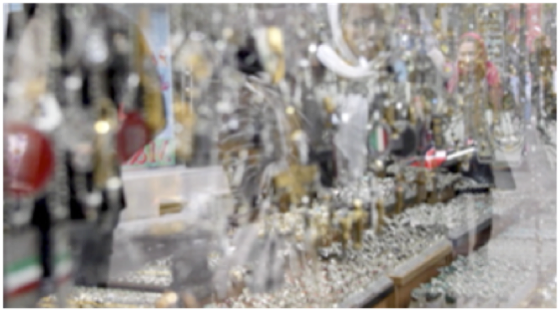
As we contemplate the origins of images, seeing them through someone else’s eyes becomes inextricable characteristic of the “original” image. Images of the elsewhere are appropriated into the imaginary. As artists in the diaspora reach out to their origins, they negotiate their own positions as well. Today, in the increasingly interconnected world, distances have diminished, and distant or prohibited places can be virtually within reach. US-based artist Shirin Mozaffari negotiates this real and virtual distance in her film Someone Else’s Project (2012). Her intention was to have a videographer shoot some footage of everyday life in her hometown, Tehran, for a project. Instead, the project turned into an obfuscated collaboration with a young woman in Tehran who chose to remain anonymous. In this exchange, Mozaffari extends her authorship to Anonymous, who assumes multiple roles as character, videographer, and, to a degree, substitute author. Working together, they highlight the censorship that prohibits them access to, and ownership of, the public space of the city, and, by extension, their own agency. Together, they overcome restrictions of access and establish a live link between “here” and “elsewhere,” “you” and “me,” “author” and “spectator.” Each collaborator is spectator as much as author of another’s project. This extended author-spectatorship encompasses others—ourselves, providing us with access to the site of practice. Both distancing and proximity are realized.
Shirin Mozaffari was born and raised in Tehran, and is currently based in the US. She holds a Master’s degree in Fine Arts from The School of The Art Institute of Chicago. Her media artwork comprises animation, video installation, and documentary film. Mozaffari participated in exhibitions and screenings at the Palais de Tokyo in Paris, The Gene Siskel Film Center in Chicago, Queensland Gallery of Modern Art in Australia; as well as festivals in Canada, Tehran, Poland, San Francisco, Switzerland, and New York. Her short film, Namesake, was awarded for the Best Art Direction at Chicago Short Film Festival in 2010.
Jinoos Taghizadeh
For Forough / 6:48 min / 2004
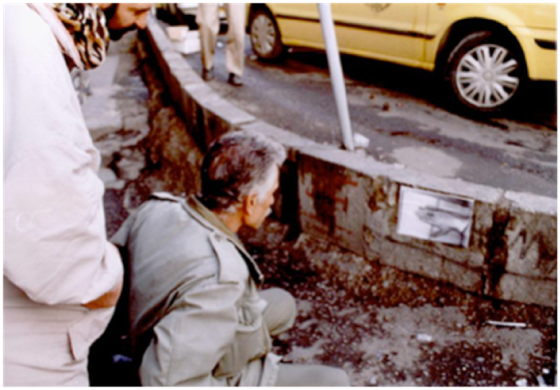
The presentation of self, particularly female self, in public is highly regulated in Iran. As a result, art practice has taken a decidedly inward turn; art venues are situated in private spaces, where they are shielded from unwanted oversight. Unsanctioned public art—performances, events, and interventions in the public space—defies prohibitions. Performances by Jinoos Taghizadeh have been exceptional in their substitutions of private and public, in her evocations of personal space in the everyday life in Tehran. In her performance For Forough, dedicated to Persian poet and filmmaker Forough Farrokhzad (1935-1967), the artist walked from a bookstore in Bagh-e-Ferdows in northern Tehran to Farrokhzad’s grave in Zahir od-Dowleh Cemetery. On walls, street posts, and sidewalks along the way, she attached posters with photocopied images of Farrokhzad’s poems, overlaid with the artist’s hands holding the books open. In these images, the artist and the poet come together in the space of the page; by posting the images containing forbidden texts around the city, despite being stopped and threatened by the police, the artist inducts her fellow citizens into the community of minds. (The action took place during the reform period prior to 2009—it would hardly be possible in the current political climate.) At the day’s end, the path to the cemetery has been marked with posters, and a group of friends has gathered to share a birthday cake served on the gravestone. Communal bond has been created in this procession—from the recent past to the present, private to public, friends to strangers, self to others.
Jinoos Taghizadeh was born (1971) and lives in Tehran. She works in performance, sculpture, installation, and video. She participated in numerous exhibitions in Tehran and abroad since 2000, and is represented by Aaran Gallery in Tehran and Isabelle van den Eynde Gallery in Dubai. Her work was included in the 2nd Thessaloniki Biennial and the 11th Istanbul Biennial; and in numerous group exhibitions, including Iran Inside Out (2009) at the Chelsea Art Museum, New York City, curated by Sam Bardaoul and Till Fellrath; and Iran via Video Current (2011) at Thomas Erben Gallery, New York City, curated by Sandra Skurvida. She served on the editorial boards of TehranAvenue and Sculpture Magazine, Tehran.
Negar Tahsili
Wee-men or Women?! / 26:00 min. / 2008
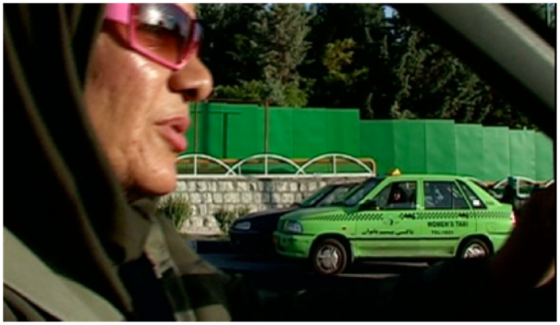
The social and political positions of and towards women in Iran—its government prohibits feminism in both theory and practice—are main concerns of Negar Tahsili’s documentary films, including her latest, The Rose and the Nightingale (2012), comprised of interviews interrogating the notions of gender in Iran with artists, critics, and academics. Her earlier film Wee-men or Women?! (2008) features a talkative female-only Tehran taxi driver at work, as it conjures-up the cinematic genre situated in a taxicab, from Martin Scorsese’s Taxi Driver to Abbas Kiarostami’s Ten. Tehran’s taxis constitute a bustling, floating world in transit that is neither private nor public, and their drivers, like benevolent bogeymen, carry passengers and news, including as informants to the government. In Tahsili’s film, potential dangers of public transportation for women traveling alone are discussed; a parallel presentation of self-defense courses for women undercuts these presumed dangers with a measure of humor. An attack comes unexpected; and neither special transportation nor martial arts will provide protection from this powerful assailant.
Negar Tahsili (b.1980), is a visual artist and documentary filmmaker based in Tehran. She holds an MA in Industrial Design from Azad University, Tehran. Her works have been screened and exhibited at Reloading Images project in Berlin (2007); FILE 2008 Electronic Language International Festival in Chicago (2008); Heinrich Böll Stiftung Film Festival in Berlin (2009) and at the Ludwig Museum in Cologne and Berlin (2013); Iran via Video Current at Thomas Erben Gallery in New York (2011); and Mise en abyme at the Cité International des Arts, Paris (2012).
Neda Razavipour and Rambod Vala
Hushhh! / 1:05 min. / 2011
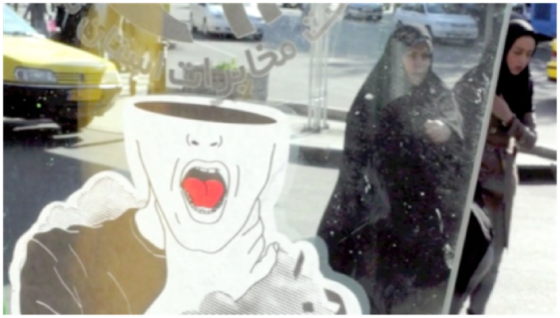
Tehran is among the most polluted cities in the world, where it hurts to breath the air sometimes. Prolonged exposure to pollution causes asthma, asphyxiation, chronic fatigue, and other respiratory illnesses widespread among Tehranis, children in particular. Pollution is political. The air quality has worsened in the recent years, as international sanctions caused shortage of imports of refined gasoline, and necessitated production of emergency fuel containing higher levels of pollutants. Artist Negar Farajiani has curated a series of presentations entitled Tehran Monoxide (www.tehranmonoxide.com), seeking to raise awareness to the causes and effects of pollution through artworks, including an ongoing street art project by Neda Razavipour Hushhh! represented in a video collage by Rambod Vala. Stickers distributed around the city proclaim, “Hushhh! Die Slowly” and “Deep Breath.” Razavipour has conceived and realized a number of performative actions engaging with the public in Tehran, including Census, 2003 (with Shahab Fotouhi); Dream Set, 2004; and Self Service, 2009. Another video by Razavipour included in the program, Find the Lost One (2009), invites the viewer to play a visual game—find “the lost one”—a figure digitally erased from one of the two side-by-side video frames of a crowd. Even though some figures have been disappeared from the crowd—or society—it keeps moving, oblivious to the loss of an individual.
Neda Razavipour was born in Tehran in 1969, and lives there. She studied art at Paris I Sorbonne University, and holds an MA in Stage Design from the école nationale supérieure des Arts Décoratifs (EnsAD). She is an interdisciplinary artist working in urban installation and performance, photography, stage design, drawing, painting, and video art. Her participatory performance installation Self Service was presented at Azad Gallery, Tehran (2009); Röda Sten Art Center, Gothenburg (2011); Devi Art Foundation, Delhi (2011); and Cité International des Arts, Paris (2012). Her other works were presented at the Tehran Museum for Contemporary Art; Pergamon Museum Berlin, and numerous other institutions around the world. Razavipour co-founded the Leeve Theatre Group; the Movazi Public Performance and Installation Group; and the Jalleh Collective Art Studio; all in Tehran.
Simin Keramati
Tehran 2011 / 0:51 min. / 2011
Tehran 2010 / 2:56 min. / 2010
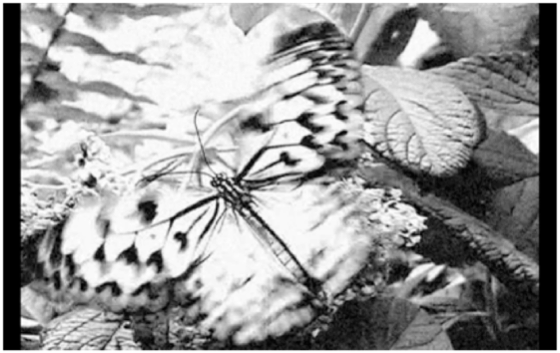
It is curious how butterflies attract attention in most precarious conditions—their beauty, their carelessness towards brevity of life never fail to catch our eye (and be caught by avid collectors—such as writers André Gide and Vladimir Nabokov, well-known to have their eyes on creatures of nature and humanity alike). Butterflies that were common in Tehran are seldom seen fluttering in the city today. The artist uses the metaphor to speak about loss of carelessness in public, and personal loss of freedom, in her short video, Tehran 2011, of a butterfly crawling upon a flower, helplessly flapping its wings. The black-and-white image is disintegrating into visual detritus of a certain beauty, as electronic crackling noise conjures up a media soundscape for this nearly extinct creature to live in. In Tehran 2010, we see a female figure exercising in the gated garden space—she flutters up and down, her robe giving her rather ominous wings, her skipping rope lashing the floor. In the third video of this trilogy, Insomnia (2010), the world outside can only be heard; its image abstracted into an undulating movement of a bedroom curtain, as the mind is trapped in the grey zone between waking and sleep.
Simin Keramati (b. 1970, Tehran) lives in Tehran and Toronto. She received an MA in Fine Arts from Tehran University. She won the Grand Prize at the Dhaka International Biennale in 2004 and was shortlisted for the Magic of Persia Contemporary Art Prize in 2009. She works in painting and video; and has been showing in Iran and internationally since 1993. Keramati has had solo exhibitions in Tehran at Aria Gallery (1997, ’98, ’99); Barg Gallery (2000, ’02); Azad Gallery (2008); Etemad Gallery (2010). Her work was included in Elephant in the Dark (2011) curated by Amirali Ghasemi at Devi Art Foundation, Delhi and numerous other exhibitions around the world.
Rosita Sharafjahan
Hurrah / 3:51min. / 2006
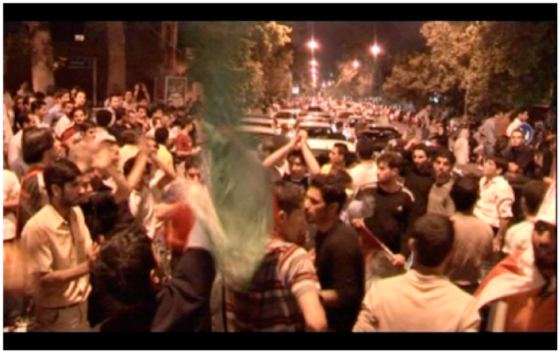
Rosita Sharafjahan emerged as an artist in Tehran concurrently with the 1979 revolution. Criticality incited by this sociopolitical upheaval continues to be the premise of her own art practice, and underlies the programming at the Azad Gallery she founded and directs, which asserts independence from political constrains and market interests alike, and seeks to provide a space for uninhibited discussion. One example is a project by Shahab Fotouhi in 2009, in which the artist turned the gallery into a presidential campaign center for the candidate Mir Hossein Moussavi. Sharafjahan is among a number of socially engaged artists in Iran who dare to look the public in the eye. Her video Hurrah (2006), comprising footage of crowds of sports fans passionately supporting their teams, with flags and other paraphernalia in stadiums and streets, is eerily evocative of images of crowds engaged in a different yet similarly expressed euphoria and unity in political upheavals—such as images from Iran that flooded media screens around the world in 2009; and again with uprisings of the Arab Spring.
Rosita Sharafjahan lives and works in Tehran. She holds a BA in Painting and MA in Art Research from Tehran University. Her numerous group exhibitions include International Triennial of Contemporary Art, Paris (2002); Tokyo Metropolitan Art Museum (2009); Ginza Gallery, Tokyo (2009); Tehran Museum of Contemporary Art (1994-2005); Hilger Gallery, Vienna (2009), and other venues in Iran and elsewhere. She founded and directs Azad Art Gallery in Tehran.
Neda Zarfsaz
Zoom-in / 5:58 min. / 2010
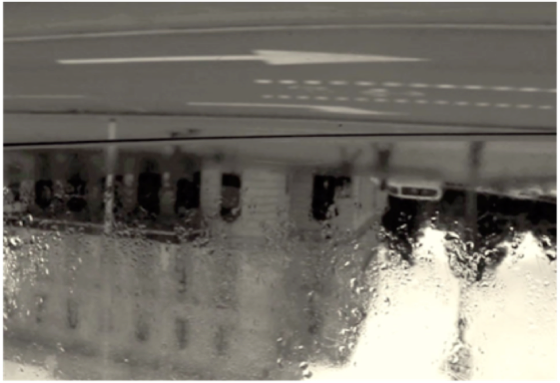
Our vision is conditioned—attuned to the environment in which we live, thus we see certain things and, due to non-recognition and thus non-comprehension, turn a blind eye on others. We carry our views along wherever we go, and as our vision adjusts in movement, our views evolve and change along the way. Self-scrutiny under the camera zoom, as it were, maps visual topographies of the mind, creating conjunctions between the outer reality and its inner vision. The dreamlike sequence of the film by Neda Zarfsaz, its upside-down world seen through a window of a slowly moving vehicle, casts this rainy European city in the viewfinder as would-be Tehran, conjured up as a somewhat foreign object in an expanded field of vision, asserting increasingly fluid coordinates of the topography of self, reconciling belonging and estrangement.
Neda Zarfsaz (b. 1981, Urmia, Iran) is a photo and video artist based in Tehran. She received an MFA in Art and Media from Gothenburg University, Sweden, in 2011; and a BA in Visual Communication Design from Alzahra University, Tehran. She was awarded the Magic of Persia Gasworks Residency in London in 2013. Her work has been presented in group exhibitions in Iran since 2006, when she participated in the First Visual Arts Festival, Resistance, at the Museum of Contemporary Art Tehran. Recently, she exhibited at Mohsen Gallery (2012) and Siin Gallery (2011), both in Tehran. In Sweden, she participated in exhibitions at Röda Sten Art Center (Gothenburg, 2011); Galleri bob (Gothenburg, 2010); Gallery Rotor (Gothenburg, 2009); and other venues.
Sandra Skurvida, New York, March 2013
Sandra Skurvida is independent curator and scholar based in New York City. Her research interests include multidisciplinary performance of the 20th and 21st centuries and digital media art and theory. She holds a PhD in Art History and Criticism from Stony Brook University, New York. Her curatorial practice is devoted to transnational exchanges in post-colonial conditions. In 2011, she founded and directs OtherIS curatorial initiative, with curated exhibitions at Cité International des Arts, Paris (2012); Thomas Erben Gallery, NYC (2011), and other screenings. Among her other curated exhibitions are Avant-Guide to NYC (apexart, NYC, 2009); Custom Car Commandos (Art in General, NYC, 2009); Soap Box Event by Pia Lindman (Federal Hall National Memorial, NYC, 2008); and the Third Annual Exhibition of Soros Center for Contemporary Art in Vilnius, Lithuania (1995).
Cities of the World is an ongoing project of ATOPIA that seeks to investigate the relationship of place and perception, and the geo-politics of artistic productions. Through a series of curated video programs, this project aims to create an understanding and appreciation of the particularities of artistic productions in distinct places.
The works in these programs are selected from a large pool of artists’ moving image works made in that city by its own residing artists. We worked on programs from various cities and completed four programs from Tehran and Sao Paolo (2013-14) and Seoul and Mexico City (2016-17).

Remembering or Floating
artists’ moving image works from Seoul
Opening: Thursday 23.03.2017 at 19:00
Atelierd Nord - ANX, Olav Ryes Plass 2, Oslo
(23 March - 2 April, 2017)
Artists:
Yongseok Oh
Sejin Kim
Ji Hye Yeom
Hyewon Kwon
Mihye Cha
Sekwon Ahn
Sook Hyun Kim
Hye Jeong Cho
Curated by: Seihee Shon
Meeting and discussion with the curator and artists: Fri. 24 March at 14:00
Cities of the World – Seoul
Remembering or Floating
Seoul, the capital of South Korea for over 600 years, is often described as a city where the past and the present, the traditional and the contemporary, exist simultaneously. In Seoul, it is common to come across a street where on one side groups of shabby apartment houses, squeezed into narrow alleys, face on the other a large, brand-new complex of residential skyscrapers. There is a saying that ten years is enough time to completely transform a country’s landscape. Even so, in Seoul one is surprised when a favourite café remains in the same place for more than a couple of years. Perhaps no other city is pursuing the idea that faster is better more intensively than Seoul.
Introducing artists working with moving image, video, and film, based in Seoul, Remembering or Floating examines how the accelerated change in Seoul is reflected in their works. As the contemporary artist, Uriel Orlow observes, acceleration provokes “an intensifying desire to capture things before they are lost for good, a general nostalgia for the past, and a self-conscious interest in, or indeed obsession with, memory both individual and collective”. This exhibition presents moving image works capturing and looking into obsolescent and declined spaces, and lost and forgotten or hidden memories. Some artists experiment with narratives and metaphors concerning the concepts and landscapes produced by contemporary society. Others use the time-space of their media to convey the social phenomenon of acceleration epitomised by the metropolis of Seoul.
Dream II (2003), by Sekwon Ahn, was shot in one single take driving on the Cheonggye flyover prior to its demolition. Opened in the late 1960s as the first city highway, the Cheonggye flyover would have transported thousands of dreams and desires of people in the rapidly growing city of Seoul, connecting the centre and its northeast. Then in 2003, following the city’s restoration plan, it disappeared into history. On a rainy Summer day in 2003, Ahn went out with his 6mm digital camera to capture the last scenery of Seoul on that bridge.
Sekwon Ahn has been photographing and filming urban redevelopment areas in Seoul since 2000. Redevelopment is still, always, on-going, in this huge city Seoul. The artist waits for the time when all the waste and debris jumbled together from demolition becomes veiled with darkness. His intention is to capture the dreams and everyday life which places would remember. Wearing all the lights of night and dawn, those sites of hard-working life appear dazzling and beautiful in his work. In the same manner, the artist has deliberately chosen a rainy day for Dream II. He wanted it to be surrealistic. He felt that the vague cityscape, blurred with the heavy rain outside the car window, was the same as a reality of Seoul which is constantly transforming. With the aerial soundtrack, the gone-away landscape in slow motion is like a fainting dream. It is a memory, illusion and a very abstract portrait.
It was one day in 2014 that Mihye Cha happened to enter the Bada cinema, while walking through central Seoul. She felt driven by the Korean word ‘bada’, which means ‘sea’. Following this encounter, the artist became absorbed by the cinema for almost two years and the outcome is People Who Disappeared, The World That Didn’t or Vice Versa (2017). South Korea was in deep sorrow in 2014 when 304 precious lives fell victim to the sinking of Sewol ferry. Mihye Cha explained that there was a connection between the reason for being caught by the word ‘bada’ and the tragic accident.
After operating as a cinema showing reruns for about 40 years, the Bada cinema officially closed in 2012. However, for some unknown reason, its signboard was still up and the cinema remained the same as before, although it no longer showed movies. It was standing on a busy street as if it was not there. “I think there is a so-called heyday in spaces, too” said the artist. Cha thinks about people who would have hung around the cinema and filled the empty seats. People Who Disappeared, The World That Didn’t or Vice Versa is a study of an empty space, memory of the space and the ways in which people relate to a space. Cha invites performers to the Bada cinema. They wander around the Bada building, like ghosts of the people who disappeared. Leaning over the walls and sitting on a seat and the stage, they attempt a physical and bodily communication with the building. They try to contact with memory embedded in the architecture.
Mihye Cha’s attitude towards disappearing things is analogous to Sekwon Ahn’s. Both the artists take a role in documenting, thereby creating a sort of visual archive of places about to disappear. On the other hand, the next two artists to introduce, Hyewon Kwon and Yongseok Oh represent the past through the use of personal or public archives and they intervene in and extend the archives by reconstructing or re-enacting.
Hyewon Kwon’s Eight Men Lived in the Room started from a black and white news recording found in the National Archives of Korea. This work is a combination of different forms such as video, sound, photography, and installation, and this time two videos are shown. First of all, Eight Men Lived in the Room – News repeats a 45 second news clip reporting the completion of a Seoul city dormitory for workers. This was the only documentary material concerning the dormitory, which operated from 1962 to 1999, in the National Archives. Thus, through the repetition, Kwon underlines the absence of documents and suggests that the archive preserves and at the same time buries certain things. Also, as the art historian Briony Fer points out, the repetition evokes the audience to view the work from a different perspective by “transforming the most everyday and routine habits of looking”.
Through alternative sources of information such as newspapers, magazines and novels of that time, Kwon traced fragments of the absent memory. Then she weaved the pieces and reconstructed a past where the dormitory, with promises and hopes for a better life, became packed with poverty and criminals, and finally ended with its demolition. Kwon recuperates the past, ignored or buried by the National Archives.
The artist seeks for a chance to discover new links in history through research into traces of the past embedded in objects or places. Eight Men Lived in the Room-Film Set is an example. Kwon found a text, entitled Ruined Citizens, which illustrates the author’s experience in a city dormitory for workers. The writing won the runner-up prize in a competition by a popular magazine of the time and was published in 1975. Eight Men Lived in the Room-Film Set is a cinematic representation of a memory from when the author had been drinking and sang a mournful popular song with his fellows. A room was built as a film set after studying a dormitory room which appeared in the news recording and lighting, camera movement and a soundtrack were added. The artist restores a past day and thereby supplements the existing archive.
Yongseok Oh is known for his collage of photography and video. I find Cross (2002) particularly interesting as it is an early collage work from the time when the artist started to experiment with assembling still and moving image. Cross began with his personal archive. The work is divided into five sections subtitled with years and places, in a similar manner to how we mark the dates and places on the back of photos. The first two photos, Cheonjeyeon 1963 and Seorim 1963, were taken from an old photo album belonging to the artist’s mother, the third, Gangjeongcheon 1980, was from the artist’s personal archive and Gwanghwamun 1950 and Deoksugung 1957, depicting historical sites in central Seoul, were found on the Internet.
In Cross, Oh extends the original image by joining still and moving images taken in the same place, but in different times, for instance, after over 20 or even 50 years have passed. There is a black and white photo of his mother in Cheonjeyeon in 1963. Almost 40 years later, Oh and his mother went to the same place and shot a video in a similar pose. This video is placed in the same plane with the old black and white photo. Images of skies, grass and rivers taken in different times are added, too, and finally a scene is completed. In this extended and combined landscape, the mother in 1963 and the mother and son in 2002 coexist. In another section, we see both the Gwanghwamun of 1950 with marks of the Korean war, and the Gwanghwamun of 2002, still in a position distorted by the Japanese colonial government, before the restoration in 2010. Cross is a multidimensional archive of specific places with different perceptions and times.
In the beginning and the end of Where We Met Genius (2015) by Ji Hye Yeom, we see a long passage and a mask. What is beyond the mask? A narrative created by the artist. Genius Loci, the guardian spirit of places is the narrator. Genius lives in a ‘place’, the Himalayas. Yeom has been to an area near the Himalayas. She was unable to climb up due to altitude sickness, but looked forth upon the mountains of the Himalayas. Like many others, the artist felt how small human beings are before the enormity of nature. Perhaps, she considered that even humans, who change everything, cannot transform the Himalayas and the Himalayas will remain the same forever.
Genius is curious to know where all the humans come from to climb the Himalayas, so it follows one of them. Having a position but yet to be a place, it is a city. Yeom draws a line between ‘place’ and ‘space’. The Himalayas are a place, which is not replaceable by other things and never changes, whereas a city is a space, which is ever-changing and replaceable according to gain and loss. Marc Augé coined the term “non-place” as an opposite to place. Unlike a place which “can be defined as relational, historical and concerned with identity”, a non-place, produced by the contemporary world, is a space which “cannot be defined as relational, or historical, or concerned with identity”. Spaces of transience such as trains, airports, leisure parks and large retail outlets are non-places.As much as non-places are easily found in cities today, it seems to correlate that Genius describes cities as spaces yet to become places. Genius goes back to the Himalayas. Making use of the only actual image shot, which depicts a scene of snow and a bonfire, to describe a ‘place’, the Himalayas, the artist stresses the contrast to a city space built with computer-generated images.
Sejin Kim’s 2 channel video Melancholiker (2016) is a metaphoric portrait of the contemporary world. In the video, two teenagers suggest a state of both uncertainty and flexibility, and of continuing to define identity. Kim remembers her adolescence, filled with worries and anxieties for the unpredictable future and the present in constant change. In the period of transition, the feeling of floating without belonging anywhere, resembles what people today experience in a fast-changing city. Skateboards “oscillating between gravity and zero gravity” are a device to signify this insecure situation.
The camera follows the teens skateboarding. They pass the centre of Seoul and ride to the Han-river park then, again in the city centre, at an art museum basement car park. In Melancholiker, speed and rhythm are notable elements. Camera movements following two characters increase the sense of speed, and Kim uses slow motion to emphasize movement in the work. Finally, the movement is made double across two synchronized screens. Such a sense of speed and movement in the video seems to signify acceleration and mobility in contemporary society. Augé argues that advanced means of transport promotes population shift and consequently increases non-places. It would therefore be relevant to construe that city roads, the Han-river park, and a basement parking lot where the teens skateboard in Melancholiker are all spaces of transience, indeed non-places.
Hold Me was the first collaboration between the two artists Sook Hyun Kim, working with experimental film, and Hye Jeong Cho, who focuses on feminist film and video. Exploring the materiality of film and time-space in film, Hold Me begins by documenting a dancer’s performance. The artists completed the film by crosscutting between the original documentary and the manipulated images, through the hand printing process. “As an artist paints”, the hand printing process enables the artist to make various interventions and results in the development of the unique aesthetics found in Hold Me.
Kim and Cho say there are three time-spaces in Hold Me: time-space of the dancer’s actual performance, time-space of the documentary film of the performance, and time-space of the manipulated documentary film. Here, the two time-spaces in the film suggest a documentary landscape containing a memory of performance and an imagery landscape transformed by the artists’ hands but still holding the memory of performance. Max Richter’s classical music streams along to the performance documentary and stops suddenly. The repetition of the soundtrack, on and off, makes distinct the divisions in time-spaces in the film.
Unlike the other works, a thematical idea directly related to acceleration is not obvious in Hold Me. However, in terms of dealing with the issues of time and space from a different, media centred, angle, I feel this work can provide various approaches and opportunities for thinking.
I would like finish this essay with the following excerpt from a short novel by Kyung-Lin Jeon, a contemporary Korean writer
The address on the obituary of the old woman was not from Ogin-dong because that place had been knocked down. The old apartment at the foot of Inwang mountain collapsed silently due to up-to-date construction methods after everyone had moved out. Which coordinate could represent the room’s window I had covered again and again with fabric to avoid the sunlight?
Seihee Shon
Seoul, Feb 2017
Artist biography
Hyewon Kwon (b. 1975)
Comparing herself to a time traveller, Hyewon Kwon attempts to discover new and unexpected connections in history by exploring traces of the past embedded in objects and places. Her recent solo/group shows include Club Monster (Asia Culture Center, Gwangju, 2016-2017), The Moon, Round Like a Little Plate (Daegu Art Factory, Daegu, 2016), Spaces of Memory 1 – Illusionary Landscape: Hyewon Kwon (Media Theater I-Gong, Seoul, 2015), and A View from the Other Side (Mooshin Art Museum, Seoul, 2014).
Ji Hye Yeom (b. 1982)
Ji Hye Yeom is interested in socio-political stories directly and indirectly associated with a place as well as the influence of ordinary spaces on humans, and tries to create personal and historical narratives together. Recent solo shows are Yeom Ji Hye – All Exiles Have a Hidden Luck (Art Sonje Center, Seoul, 2015) and Wrong Move (Media Theater I-Gong, Seoul, 2014) and group shows include Under My Skin (Hite Collection, Seoul, 2016) and Sleepless (Gallery Zandari, Seoul, 2015).
Mihye Cha (b. 1981)
Mihye Cha thinks about the possibility of something both happening and not happening and imagines an invisible area. The artist is interested in the gap and an encounter between different worlds. Her recent solo/group shows/festivals include Full, Empty, Floating (Cake gallery, Seoul, 2015), Vanishing Point (Space Onewall, Seoul, 2016), Asia Film and Video Forum (National Museum of Modern and Contemporary Art, 2015), and Random Access 2015 (Nam June Paik Art Center, Korea, 2015).
Sekwon Ahn (b. 1968)
Filming and photographing the same areas over several years or even a decade, the artist witnesses and documents traces of time kept in changing landscapes. Thus, in his work, the viewers can encounter the fragments of lost sceneries destroyed in the name of urban development. His recent group exhibitions include Experiment of Architopia (National Museum of Modern and Contemporary Art, Seoul, 2015), Variations of the Moon (Nam June Paik Art Center, Korea, 2014) and Move on Asia Video Art (ZKM Media Museum, Germany, 2013).
Sejin Kim (b. 1971)
Working with a variety of media apparatuses such as documentary realism and cinematic language, Sejin Kim explores various and perplexing relationships between individuals and contemporary society. Her recent solo/group shows include 16th Seoul International New Media Festival (opening screening, 2016), The Paranoid Zone (National Museum of Modern and Contemporary Art, Seoul, 2016), Galaxias Maculates (Museo de Arte Contemporaneo de Valdivia, Chile, 2015) and Proximity of Longing (Cutural Station 284 RTO, Seoul, 2014). Recently, she won the SongEun Art Award 2016.
Sook Hyun Kim (b. 1980) & Hye Jeong Cho (b. 1973)
Addressing and experimenting with the format of combining moving image, dance, and performance, Sook Hyun Kim and Hye Jeong Cho started to work together in 2013. With the following works, Hold Me (2013), The Emotional Society on Stage (2014), and Screens + Action! (2016), the artist duo has been included in Unforeseen (National Museum of Modern and Contemporary Art, 2016), Rhythm Landscape (Gyeonggi Museum of Modern Art, 2015), 16th Jeonju International Film Festival (2015), and Seoul International New Media Festival (2014).
Yongseok Oh (b. 1976)
Yongseok Oh creates imaginary scenes by joining images from various sources such as movies, the internet and photos taken by the artist. Thus, in his landscapes, different times, places, views, still images and moving images coexist. His recent solo/group shows include Seoul International New Media Festival (2016), New Media Art from Korea (Le Murate Center for Contemporary Art, Florence, 2015), The Horizontal Line Without Cut (Art space Jungmiso, Seoul, 2014), and Digital Triangle (Art Space Loop, Seoul, 2014).
Footnotes:
1. Uriel Orlow, ‘Latent Archive, Roving Lens’ (2006) in Memory, ed. Ian Farr (London: Whitechapel Gallery, 2012) 204
2. Interview with the artist, A View from the Other Side exhibition catalogue (Seoul: Sookmyung Women’s University Moonshin Museum, 2014) 26
3. Minhwa Yoon, Things Remained Even after The Loss or Mourning for The Heart, 2015, Accessed 29 December 2016, https://neolook.com/archives/20151010i
4. Charles Merewether, ‘Archives of the Fallen’ (1997) in The Archive ed. Charles Merewether (London: Whitechapel Gallery, 2006) 160.
5. Briony Fer, ‘The Infinite Line’ (2004), Memory, ed. Ian Farr (London: Whitechapel Gallery, 2012) 73.
6. The artist mentioned that he shot the moving image again in the Cheonjeyeon section in 2008, to improve its picture quality.
7. The central gate, Gwanghwamun, to the main palace was relocated due to the construction of the Japanese General Government building. Japan did this in such a way that the Korean tradition was desecrated. The restoration started in 2006 and completed in 2010.
8. Marc Augé, Non-Places: An Introduction to Supermodernity, trans. John Howe (London and New York: Verso, 2008) 77-78.
9. Ibid., 34.
10. In conversation with the artist, 2016
11. Marc Augé, Non-Places: An Introduction to Supermodernity, trans. John Howe (London and New York: Verso, 2008) 34
12. In conversation with the artist, 2017
13. In conversation with the artist, 2017
-
14. Kyung-Lin Jeon, ‘Ledge of Lilies’, in Angels Stay Here (Paju: Munhakdongne, 2014)
This Program is sponsored by:
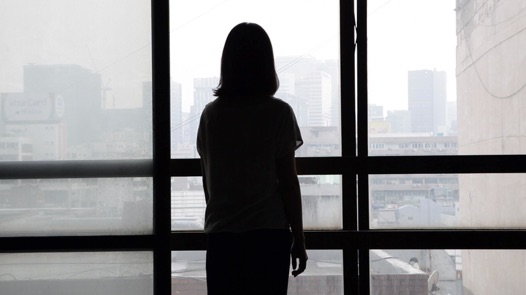

Still from “People Who Disappeared, The World That Didn’t or Vice Versa”, Mihye Cha, 2017
© Atopia Stiftelse, 2018 -
Cities of the World: Mexico-City
Artists’ moving image works from Mexico-City
Exhibition place: Atelierd Nord - ANX Gallery, Olav Ryes Plass 2, Oslo
7-17 Dec. 2017
Curated by: Miguel Jara
In Xochitl in Cuicatl (in-flower-and-in-chant)
Artists:
Andrés García Franco
Annalisa D. Quagliata
Antonio Arango
Daniela Libertad
Eduardo Makoszay
Fernan Martinez
Geni Thalia
Tania Ximena
Yollotl Alvarado
Txema Novelo
What is the role of geography in our perception of the world? We even react differently to such a question in different places. How differently does this question echo in Oslo, Mexico-City, Tehran, Sao Paulo, Seoul? Every place produces its own set of premises and every artwork carries the spirit of its production place.
In Xochitl in Cuicatl (in-flower-and-in-chant) is a curated program of artists’ moving image works from Mexico-City. ATOPIA has invited the independent curator Miguel Jara to collaborate on this final edition of the Cities of the World project.
The program brings together works by ten contemporary artists who live and work in Mexico-City. These works examine and reflect the dilemmas and tensions of a rapidly changing mega city.
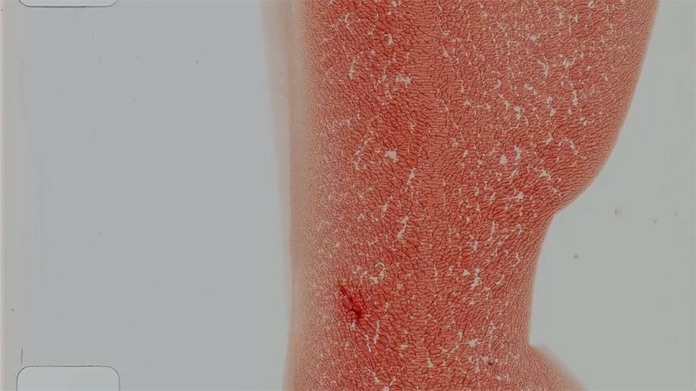
With the efforts of Norske Kunstforeninger the two programs of Cities of the World: Seoul and Mexico-City will tour around the country throughout 2018.
In our earlier collaboration with Norske Kunstforeninger the two programs from Tehran and São Paulo were also presented in several regional art spaces in 2016.
